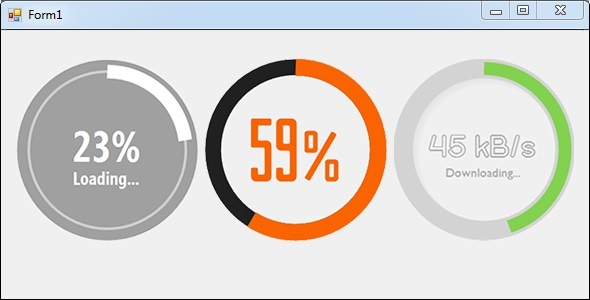
The ProgressWheel for Windows Forms is a custom control designed to replace traditional progress bars with a visually engaging circular loader. Built using GDI+, this lightweight component transforms the user experience in desktop applications by providing smooth progress visualization through customizable circular indicators. Rather than conventional linear bars, it features dual-text display and layered circular elements that create depth and modern aesthetics.
Key Features and Visual Customization
This GDI-rendered control offers extensive customization capabilities through its adjustable properties:
- Dual Text Layers: Display primary and secondary text (like percentage and status) with independent font, color, and vertical positioning via SecondaryTextOffsetY.
- Multi-Layered Ring Design: Configure three concentric elements:
- Base Circle (solid center disk)
- Base Ring (outer boundary)
- Progress Ring (animated indicator)
- Shadow Effects: Enable inner shadows on the base circle using AddBaseCircleInnerShadow and adjust lighting with InnerShadowFocalPoint.
- Progress Direction Control: Set clockwise or counter-clockwise animation via the Clockwise boolean property.
Core Technical Properties
Essential properties for functional implementation include:
- Value Ranges: Define progress boundaries with Minimum and Maximum values
- Real-Time Updates: The Value property dynamically updates the wheel, triggering the ValueChanged event for callback handling
- Unit Display: Append measurement units (%, sec, etc.) using the Unit property
- Visibility Toggles: Control element display with ShowBaseRing, ShowPrimaryText, and ShowSecondaryText
Practical Implementation Guide
Integrating the ProgressWheel involves these key steps:
- Add the control to your Visual Studio toolbox
- Drag onto the form and set Minimum/Maximum values
- Customize visual elements:
- Set ProgressRingColor to match branding
- Adjust ProgressRingThickness for visibility
- Configure text layers with PrimaryTextFont and SecondaryTextColor
- Update progress programmatically:
progressWheel1.Value = currentProgress;
Performance and Use Cases
Leveraging GDI+ ensures resource efficiency for enterprise applications and long-running operations. Ideal implementations include:
- Software installation wizards
- File processing interfaces
- Data synchronization dashboards
- Multi-step configuration forms
Unlike default WinForms progress bars, the circular design provides natural animation space and occupies smaller screen real estate, making it suitable for compact UI layouts.
Advanced Styling Techniques
For sophisticated visual effects:
- Combine BackgroundRingColor and BaseRingColor for contrast
- Set BaseRingThickness > ProgressRingThickness for “track and progress” differentiation
- Use radial color gradients on the base circle for pseudo-3D effects
- Animate between multiple ProgressRingColor values during critical operations
The ProgressWheel class provides XML documentation for all members in the main package, with Intellisense support in Visual Studio.
Best Practices
Achieve optimal UX results by:
- Limiting secondary text to 20 characters
- Maintaining 10-15px contrast padding between rings
- Using event handlers for progress-completion actions
- Testing high-contrast color schemes for accessibility
Regular updates to the Value property (every 50-150ms) create smooth animation without CPU overutilization thanks to double-buffered rendering.
This lightweight sub-50KB assembly elevates conventional progress indicators into dynamic visual elements while maintaining GDI+’s compatibility across Windows OS versions. Its extensive property set enables designers to craft loader experiences matching modern UI trends without compromising WinForms’ robustness.

